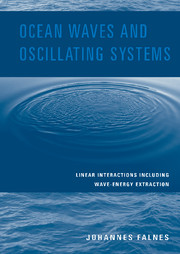Book contents
1 - Introduction
Published online by Cambridge University Press: 14 May 2010
Summary
In this book, gravity waves on water and their interaction with oscillating systems (having zero forward speed) are approached from a some what interdisciplinary point of view. Before the matter is explored in depth, a comparison is briefly made between different types of waves, including acoustic waves and electromagnetic waves, drawing the reader's attention to some analogies and dissimilarities. Oscillating systems for generating or absorbing waves on water are analogues of loudspeakers or microphones in acoustics, respectively. In electromagnetics the analogues are transmitting or receiving antennae in radio engineering, and lightemitting or light-absorbing atoms in optics.
The discussion of waves is, in this book, almost exclusively limited to waves of sufficiently low amplitudes for linear analysis to be applicable. Several other books (see, e.g., the monographs by Mei, Faltinsen, Sarpkaya and Isaacson or Chakrabarti) treat the subject of large ocean waves and extreme wave loads, which are so important for determining the survival ability of ships, harbours and other ocean structures. In contrast, the purpose of this book is to convey a thorough understanding of the interaction between waves and oscillations, when the amplitudes are low, which is true most of the time. For example, on one hand, for a wavepower plant the income is determined by the annual energy production, which is essentially accrued during most times of the year, when amplitudes are low, that is, when linear interaction is applicable. On the other hand, as with many other types of ocean installations, wave-power plants also have their expenses, to a large extent, determined by the extreme-load design. The technological aspects related to conversion and useful application of wave energy are not covered in the present book.
- Type
- Chapter
- Information
- Ocean Waves and Oscillating SystemsLinear Interactions Including Wave-Energy Extraction, pp. 1 - 3Publisher: Cambridge University PressPrint publication year: 2002



